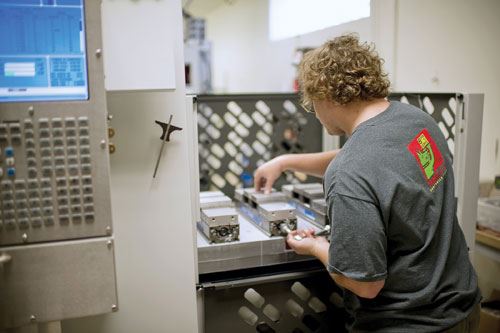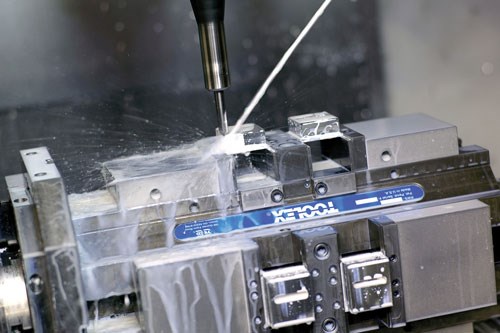Loading the player ...
Haas produced and submitted this video as a companion piece to the Thorlabs case study. It provides a glimpse inside Thorlabs as well as additional commentary from the personnel quoted in the article.
Although Thorlabs’ catalog of mail-order photonics products already weighs in at a shelf-busting 12 pounds, recent developments indicate it could be even bigger in the near future. The company’s recent move into a new headquarters building has freed plenty of space at the previously used facility—enough to house more than 100 new CNC machine tools that will be used to substantially increase the proportion of products manufactured in-house. Patrick Mulvoy of the company’s mechanics business unit, who oversees the machine shop, says the majority of those machines will come from the same builder: Haas Automation (Oxnard, California). “Five years ago, we were using machine tools supplied by a number of different manufacturers,” he says. “We decided to standardize, and Haas stepped up to the plate.” He cites the machines’ productivity, reliability and reasonable pricing as reasons for adopting that brand.
The machines are also flexible, adds Rick Chiong, mechanics business unit leader, and that’s important because of the company’s business model. Founded in 1989 by president Alex Cable, Thorlabs operates 15 facilities in eight different countries, although half of its 850 employees are based in Newton, New Jersey. The company supplies photonics products to customers that develop light-based technologies ranging from supermarket checkout scanners to life-saving medical imaging equipment. Most sales are made via the company’s website, and the ability to quickly supply more than 20,000 different laser and fiber-optic system building blocks, including optomechanical components, motion control systems, imaging devices and more, is “a large part of why we are successful,” Mr. Chiong says. “It’s very easy to Web-search for similar products elsewhere, so we have to have the product on the shelf all the time and be able to deliver without delay.”
The 100+ new machines used to reach that goal will join 10 existing models: six VF-3SS high speed machining centers with automatic pallet changers; three EC-400 HMCs, two with six-station pallet pools; and a DT-1 drill/tap center. All the VF series VMCs were purchased with rotary tables and pallet changing systems, Mr. Mulvoy says. With pallet changers, operators can load and unload components offline while the spindle is still cutting. As for the rotary tables, adding a fourth axis provides flexibility by enabling the VMCs to replicate some processes performed using tombstone fixtures on the EC-400 pallet-pool horizontals. Finally, the use of pallet pools facilitates lights-out machining, a capability that is said to help Thorlabs stay competitive.
Carefully planning each machine’s role helps the company manage the varying requirements of its product mix, which includes materials ranging from aluminum to stainless steel produced in a range of volumes. For a typical component, such as a mirror mount, the company might produce around 40,000 units per year, but some parts are produced in annual volumes ranging to 110,000 units or more. That’s why the company has different Haas machines set aside for one-off prototypes, families of parts and high-volume components. One particular EC-400 pallet pool, for example, will make two components for the rest of its life. “We bought it for a specific high-volume purpose,” Mr. Mulvoy says. “We foresee a life expectancy of up to 15 years, which is a very impressive ROI.”
Having machines set up for certain tasks and volumes also aids personnel deployment. “Operators can switch from one job to another without problems or assistance from senior staff,” he explains. As an example, he cites a particular machining center that produces a family of 12 different parts. Several of the components are mounted on a 36-inch workholding bar to enable flipping the whole row and cutting off the back side. This setup yields about 70 parts per load—enough to enable the operator to walk away and do something else for an hour.
Finally, all of the Haas machines are fitted with the builder’s Intuitive Probing Systems. These systems are said to be particularly useful for machining stainless steel parts because the company can use broken-tool-detection capabilities between spot drilling, drilling and tapping. “If a tool breaks, the others don’t follow,” Mr. Mulvoy says.
“The Haas machines hold tight tolerances, are user friendly and can accommodate a lot of tools, which helps minimize setups,” Mr. Chiong concludes. “They are also fast, which is important because everything we do has a bottom-line impact.”












































.jpg;maxWidth=300;quality=90)













